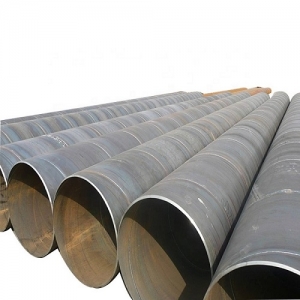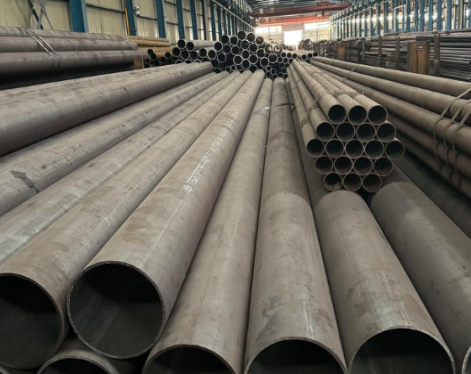The reason why welded steel tube produces oxide skin
Oxide skin is a corrosion product formed by the oxidation of welded steel tube at high temperature. It is composed of ferrous oxide(FeO), Fe3O4 and Fe2O3. From the inside to the outside: FeO, Fe3O4 and Fe2O3. Among them, FeO has a loose structure and has a weak protective effect, while Fe3O4 and Fe2O3 have a dense structure and have better protective properties.
The oxide layer is brittle and has no extensibility. It is easy to crack and detach under mechanical action and thermal processing. On the original oxide scale, there are always cracks that reach as deep as the matrix. When the electrolyte pours into the crack, the iron and oxide scale form a primary battery. The oxide scale is the cathode, and iron acts as the anode to accelerate corrosion. Therefore, the larger the area of oxide scale, the faster the corrosion rate of the steel matrix and the more serious the corrosion.

Welded steel tube(such as ERW pipe) hazards of oxide skin
In addition to causing a large amount of steel losses, oxide skin will also cause many adverse consequences, mainly including:
(1) Oxide skin makes the surface of forgings rough;
(2) Removing the oxide skin requires adding some additional auxiliary processes and equipment;
(3) The oxide skin has high hardness, which not only increases the consumption of deformation energy during forging, but also accelerates the wear of the forging die and reduces the service life;
(4) The oxide skinchemically corrodes the refractory bricks, causing premature damage to the bottom of the heating furnace.
How to remove oxide skin from welded steel tube
In the actual production process, there are many ways to remove the oxide layer of welded pipes. Here are some commonly used methods.
1. Mechanical removal method
Use mechanical tools such as grinders, polishers, etc. to polish the surface of the welded pipe to remove the oxide layer. This method is suitable for smaller welds.
2. Chemical removal method
Use acidic or alkaline solutions to treat the welding surface to remove the oxide layer. This method is suitable for large areas of welding surfaces, but attention needs to be paid to the concentration of the solution and the processing time.
3. Electrochemical removal method
A layer of electrolyte is applied to the welding surface, and a direct current is used to pass through the air gap between the coating and the workpiece to remove the oxide layer through an electrochemical reaction. This method is suitable for smaller welds and complex-shaped welding surfaces.
In short, choosing the appropriate method to remove the oxide layer of welded tubes can effectively improve the quality and aesthetics of welded pipes and ensure the service life and safety of welded pipes.
Oxide skin is a corrosion product formed by the oxidation of welded steel tube at high temperature. It is composed of ferrous oxide(FeO), Fe3O4 and Fe2O3. From the inside to the outside: FeO, Fe3O4 and Fe2O3. Among them, FeO has a loose structure and has a weak protective effect, while Fe3O4 and Fe2O3 have a dense structure and have better protective properties.
The oxide layer is brittle and has no extensibility. It is easy to crack and detach under mechanical action and thermal processing. On the original oxide scale, there are always cracks that reach as deep as the matrix. When the electrolyte pours into the crack, the iron and oxide scale form a primary battery. The oxide scale is the cathode, and iron acts as the anode to accelerate corrosion. Therefore, the larger the area of oxide scale, the faster the corrosion rate of the steel matrix and the more serious the corrosion.

Welded steel tube(such as ERW pipe) hazards of oxide skin
In addition to causing a large amount of steel losses, oxide skin will also cause many adverse consequences, mainly including:
(1) Oxide skin makes the surface of forgings rough;
(2) Removing the oxide skin requires adding some additional auxiliary processes and equipment;
(3) The oxide skin has high hardness, which not only increases the consumption of deformation energy during forging, but also accelerates the wear of the forging die and reduces the service life;
(4) The oxide skinchemically corrodes the refractory bricks, causing premature damage to the bottom of the heating furnace.
How to remove oxide skin from welded steel tube
In the actual production process, there are many ways to remove the oxide layer of welded pipes. Here are some commonly used methods.
1. Mechanical removal method
Use mechanical tools such as grinders, polishers, etc. to polish the surface of the welded pipe to remove the oxide layer. This method is suitable for smaller welds.
2. Chemical removal method
Use acidic or alkaline solutions to treat the welding surface to remove the oxide layer. This method is suitable for large areas of welding surfaces, but attention needs to be paid to the concentration of the solution and the processing time.
3. Electrochemical removal method
A layer of electrolyte is applied to the welding surface, and a direct current is used to pass through the air gap between the coating and the workpiece to remove the oxide layer through an electrochemical reaction. This method is suitable for smaller welds and complex-shaped welding surfaces.
In short, choosing the appropriate method to remove the oxide layer of welded tubes can effectively improve the quality and aesthetics of welded pipes and ensure the service life and safety of welded pipes.









